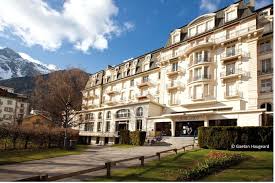Filed under: Travel pieces | Tags: alpine, Balmat, Biarritz, Chamonix, France, holidays, mer de glace, mountain cimbing, St. Gervais, Victorian era, winter sports
“O, wind, if winter comes, can spring be far behind?” Percy Bysshe Shelley
 I went to the Musee Alpine in Chamonix yesterday. I had been reluctant to go, given that I don’t like the cold nor winter sports and figured this is what the museum is composed of. But, I went, and it’s good that I did.
I went to the Musee Alpine in Chamonix yesterday. I had been reluctant to go, given that I don’t like the cold nor winter sports and figured this is what the museum is composed of. But, I went, and it’s good that I did.
The guide enunciated throughout her tour, was charming, informed, and a bonafide Chamonard to boot. What I discovered is that the name of Chamonix had changed perpetually due to boundaries being re drawn and small disputes between nearby communes. For example, St. Gervais had attempted to ‘claim’ Mont Blanc rather than Chamonix, despite its being miles away. And Turin had been a part of the Haute Savoie.
What is particularly interesting to me is how the village evolved over the last two hundred years. It was once solely inhabited by a very rural, agricultural people who were afraid of the mountains, believing them “cursed” by demons. I understand this – at the top of the mountains in the winter the howling of the wind is akin to what monsters might sound like. The residents scratched out a living during the six months of temperate weather with agricultural pursuits, then spent six months making garments out of wool, fur and wood. Now, it’s a place in which most of the residents capitalize on tourism, making it their primary source of income, from becoming mountain guides, ski instructors, and certified sportsmen, to the many shops and restaurants (only really) open during the winter and summer seasons. Additionally, many of the Chamonards have sold homes that have been in their families for generations to the wealthy French, Italians and Swiss who like to holiday in Chamonix.
Indeed, during the turn of the 18th and 19th century, Chamonix was much like Biarritz in that European aristocrats visited in droves, and as a consequence huge, grand hotels were built to accommodate them. These were later destroyed or turned into something else when the same aristocrats went elsewhere and France passed laws to give all French people the opportunity to go on holidays themselves.
From the late 18th century, Chamonix’s mountains also became a site for scientific study during a type of ‘enlightenment’ age. The stories of climbing Mont Blanc are astounding in their arduousness and danger. It’s no wonder the grumpy Jacques Balmat, who made the first ascent of Mont Blanc in the mid 1700’s, wearing wool and leather, is so famous around the valley. This eventually led to the arrival in droves of Victorians to Chamonix for ‘the mountain cure’ and glorious retreat for alpine sports, further cementing its designation as a tourism hot spot.
The culmination of the museum visit is a room that holds a series of paintings of the Mer de Glace, created by various visiting painters over the epochs. What one observes while looking at all of these paintings of the same subject, is that despite each of the paintings being almost identical in their vantage point, each of them looks slightly different. This is arguably not only a matter of perception, but also a metaphor for the dynamic aspects of the mountains and nature itself.
Filed under: Book reviews | Tags: 19th century, Charlotte Bronte, Emily Bronte, feminism, Gothic fiction, historical romance, Jane Eyre, religious fervor, Rochester, romance, romantic novel, Victorian era, Victorian novels
 For Valentine’s Day, I thought I’d write about one of my favorite romantic novels, which I just happened to re read recently. It’s good that I re read it, too, because when I had to read it in high school, I was not impressed – I found it decorative, stilted, and, well, boring. This time, decades letter, I realize how much I didn’t understand in the first reading (as well as how badly my English teacher taught the book!). Jane and Rochester’s relationship is ‘saucy’ and risqué, with motifs of masochism. Moreover, Jane is not the dull woman I initially thought she was, but a spirited and thoughtful feminist who challenges the status quo of society.
For Valentine’s Day, I thought I’d write about one of my favorite romantic novels, which I just happened to re read recently. It’s good that I re read it, too, because when I had to read it in high school, I was not impressed – I found it decorative, stilted, and, well, boring. This time, decades letter, I realize how much I didn’t understand in the first reading (as well as how badly my English teacher taught the book!). Jane and Rochester’s relationship is ‘saucy’ and risqué, with motifs of masochism. Moreover, Jane is not the dull woman I initially thought she was, but a spirited and thoughtful feminist who challenges the status quo of society.
Set in nineteenth-century England, the novel begins with the story of young Jane, an orphan who lives with an aunt who dislikes her and doesn’t show her any kindness or affection. When she’s ten, Jane is sent to Lowood, a charity school; despite the cruelty of its headmaster, Jane develops physical, intellectual, and emotional strength. She leaves Lowood School to become a governess for Adèle, the ward of Edward Rochester of Thornfield Hall. Jane and Rochester fall in love despite the difference in their ages and social positions. Mystery surrounds Rochester, however; strange sounds and occurrences abound in his manor. Jane leaves Rochester after the revelation that he is married and his wife, who is insane, is being held captive in the attic at Thornfield. After much suffering, Jane becomes the mistress of a village school. She later discovers that she has living relatives and inherits a fortune, which enables her to return eventually to Rochester as an independent woman.
Jane’s life unfolds as a dramatic adventure within an atmosphere of psychological dread and the constant threat of ruination, typical of Gothic novels. Even as there is mystery, suspense, and horror, which define the genre, the novel addresses social issues of the day. Throughout the narrative, Charlotte Bronte raises questions about the limited education provided in church schools, the expectations and opportunities for women, the value of family connections, and the importance of romantic love even when it conflicts with personal principles or the strict values of Victorian society. As a biographical note, which I think enhances one’s understanding of the book, Brontë incorporated into the narrative several elements from her own life. After Brontë’s mother died, an aunt assisted in caring for the Brontë sisters (Charlotte, Maria, Elizabeth, and Emily). The sisters were sent to Cowan Bridge, a school for clergymen’s children. The cruel and hypocritical fervor of the headmaster in Jane Eyre is based upon the evangelical minister who ran Cowan Bridge. Jane’s loss of her dearest friend at Lowood School to tuberculosis recalls the deaths of Brontë’s two sisters who died of tuberculosis at Cowan Bridge. Like Charlotte Brontë, Jane becomes a governess, which was often the only professional option for an educated woman at the time. The role of governess provided a good vantage point for Brontë to observe and write about the oppressive social practices of nineteenth-century Victorian society. Reflecting Brontë’s early feminist ideals, Jane is rebellious at a time when women were expected to be docile and obedient. Through Jane Eyre, Brontë challenges Victorian mores by suggesting a woman’s merits demand the same respect as a man’s; moreover, she challenges the conventions of Victorian literature by creating a well-developed heroine with a rich inner life.
But even as Jane questions gender expectations, societal conventions, religious practices, and the importance of love in marriage, this is not a didactic or dogmatic book. It is, ultimately, a passionate and seemingly impossible love story set within a spooky atmosphere, whose central tenet is the individual’s quest for an independent identity (still very relevant today), which is why it’s one of the most widely read novels all time.